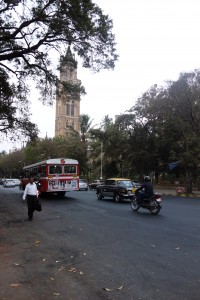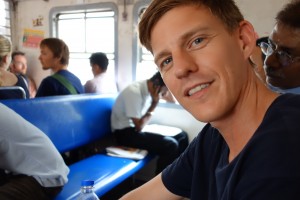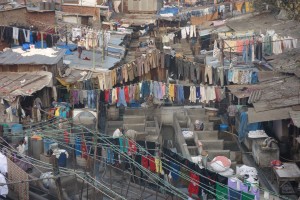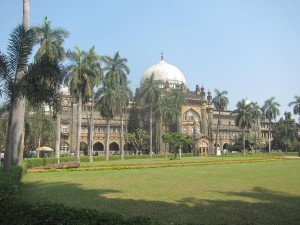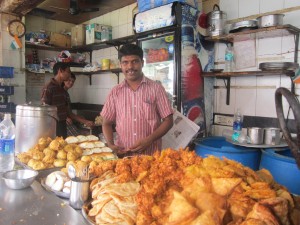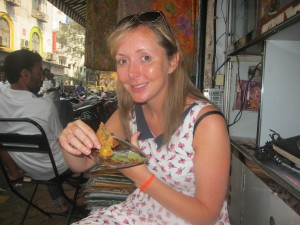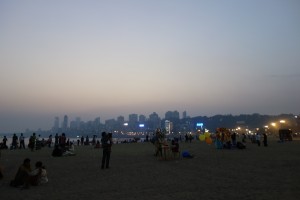Our first Indian sleeper bus experience: we applied the usual technique of locating where our bus was leaving from – ask as many people as possible and then go with the consensus – and found ourselves on a busy roundabout in Mapusa. We sat and watched for a bit and scratched our head and thought ‘that can’t be right’. But it was. The buses don’t actually stop, they just slow; a gaggle of ticket-waving people rush the bus, thrusting ticket in the face of the conductor who, for a lucky few at least, nods that this is the correct bus. If you get this far then you scream, run back to where you left your luggage, find your wife nonchalantly munching a corn-on-the-cob, scream again, grab the luggage, attempt to fling it on the back of the bus, run back to the front of the bus and jump on. All this time the bus is creeping along and, once it navigates through the roundabout traffic, will be gone! The bunk we were given can only be described as a padded cell, about 3′ high and about the size of a double bed, with a sliding door and an iron bar running the length of the window. Strange to say, but it wasn’t actually that bad; a couple of sleeping pills later and next thing we knew we were in Mumbai.
They warned us, the other travelers we met on the way, they warned us about Mumbai. It’s too crowded, too expensive, too difficult, two days is too much they said. Nary a soul had a good word to say. But what is wrong with these people? Of course its crowded, manic, chaotic, but this is India, not the outer Hebrides. We were close to cutting our time short here, such was the negativity, but so glad we didn’t.
We stayed at the optimistically named Delight Guest House. In not so much a room as partition of a larger room, where the partition walls don’t quite reach the ceiling, and the voices of the unexplained multitudes of African tenants and inevitable Israeli travelers drift in through the gaps. But it was clean, had room service and, inexplicably even to us, we loved it.
The Delight is in Colaba, on the southern-most tip of the city. We could see the Gateway to India and the Taj Mahal Hotel from our window. Each day we would stroll through Colaba and the Fort district, which is home to most of the architectural delights of the city. Now, what the both of us know about architecture you could fit on the back of a stamp, but here it is so prepossessing: a blend of Colonial Gothic, Islamic, Hindu, Mughal, Catholic and art-deco styles, often all in one building! Most if not all were built by the British, but with a nod towards those other styles they found already here, remnants of empires past; a fitting metaphor for the city – and the country – itself really.
Almost immediately north of Chhatrapati Shivaji Terminus (Victoria Station to you or I, and the crown jewel of those aforementioned buildings), the streets coalesce into tumultuous bazaars and markets, the people seem to multiply and the volume turns up a few notches. This is the Mumbai we imagined, and it feels like any other Indian city we’ve been to.
We took a guided tour of the Dharavi slum which was fascinating, a real eye-opener. The largest slum in Asia, Dharavi is home to upwards of a million people. It is shaped somewhat like a heart and by dint of that poetic Indian symbolism, is known as the heart of Mumbai. Although it is undoubtedly a slum, the people who live there don’t just mope around swatting flies all day. It’s industriousness is famous – plastic recycling, pottery, poppadoms, ironware, cardboard – the slum generates $650 million per annum; people also live in the slum and commute to the city.
Although it’s a little disheartening to see kids playing in the refuse heaps or toying with dead vermin, they honestly seem like they’re having a whale of a time! No matter what they’re doing they’ll drop it the minute they see a white face to scream “HELLO-HOW-ARE-YOU?” and descend into fits of giggles. The company running the tour – Reality Travels – pump a large amount of cash back into Dharavi to provide schools, sports programmes and more.
Finally, the Mumbai street food is delectable. Bhelpuris, pav bhajis, samosas, wadas, dosas, iddli and numerous other delicacies that we didn’t quite catch the name of; and refreshing lime juice or sugar-cane juice stalls every 50 metres or so. There was one place near our hotel where, one night, we got a thali (rice, 2 curry dishes, popadom, lime chutney), 2 wadas (like a veg-burger sandwich), about 8 onion bhajis and a bottle of water for 87 rupees (about £1). They knew us by sight in the end and we daren’t walk past without gulping down a quick snack.
And now for something completely different: we leave South India and fly out to Amritsar tomorrow, where we’ll be meeting up with my parents and embarking on a little Himalayan adventure.

